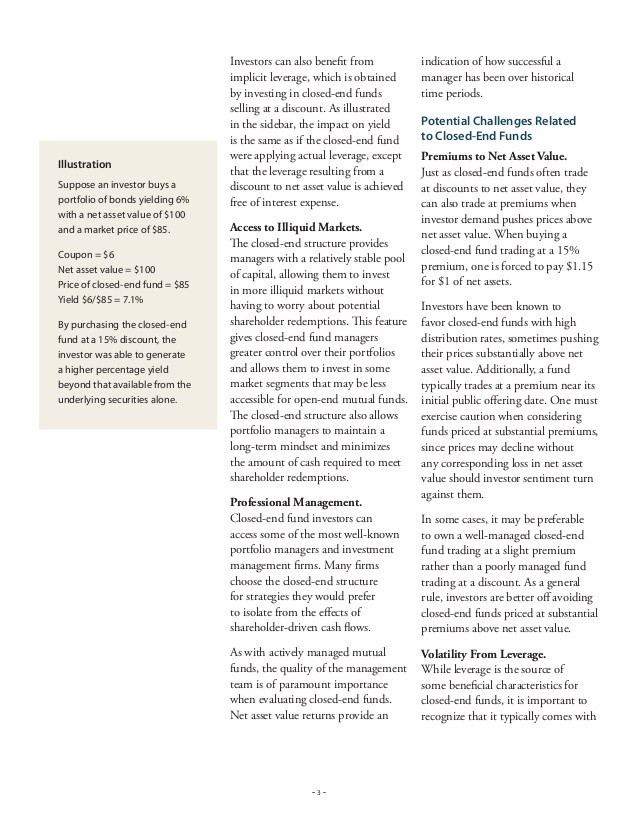The differences between Mutual Funds ClosedEnd Funds and ETFs
Post on: 6 Август, 2015 No Comment

In this constant fast-paced climate, investors are faced with a rapidly changing financial market. The market’s growing complexity may seem a bit overwhelming for even the savviest individual, not to mention the novice investor. Luckily, there are many investment options out there for those looking to gain exposure to the world’s debt and equity markets that don’t require a significant investment of time or energy.
Three of the most popular investment options available for individual investors are mutual funds, closed-end funds, and exchange-traded funds (ETFs). The latter product group is the newest entrant and has experienced rapid growth in product offerings, assets under management, and public recognition in recent years. Each of the three choices offers individuals a diversified portfolio, without the headache of building or maintaining a collection of individual equity or bond holdings.
The most widely used of the aforementioned investments is the mutual fund. According to the Investment Company Institute, 53.8 million households (44% of total U.S. households) owned mutual funds in 2012. A mutual fund is a financial instrument that allows a group of investors to pool its money, giving an appointed portfolio manager the flexibility to invest in multiple sectors and stocks at a scale that the individuals would not be able to themselves. For their monetary contribution, investors receive shares in the mutual fund. Shares are purchased directly from the fund at the actual value of the shares, or Net Asset Value. (Net Asset Value is abbreviated NAV, It is calculated by taking the net assets of the fund and dividing it by the total number of shares.) There is no secondary market for mutual fund shares; however, the fund stands ready to buy and sell shares every day at market close at NAV, which is why they are called open-end funds. The portfolio manager buys and sells stocks and securities often on a daily basis according to the style dictated by the fund’s prospectus. Mutual funds charge fees to operate and manage the fund. All mutual funds are subject to a strict set of rules set forth by the Securities & Exchange Commission. Value Line tracks about 20,000 mutual funds, with easy access to each fund’s key statistics in the Fund Advisor product.
Another option for investors is closed-end funds. This investment vehicle is both similar and, in some ways, quite different from an open-end mutual fund. Like its open-end counterpart, a closed-end fund offers investors an easy way to diversify their portfolio. It is also professionally and actively managed by an investment advisor and is required to distribute capital gains and dividends to its shareholders. Unlike a mutual fund, however, there are only a set number of shares of the fund authorized by the investment management company. As such, a closed-end fund trades on an exchange and behaves like a stock, with its market value driven by the supply and demand for the shares. Such characteristics allow closed-end funds to be purchased and sold throughout the trading day. They are often bought at a premium or discount to the value of the portfolio’s underlying assets or net asset value (NAV). The Value Line Investment Survey tracks the performance of several closed-end world equity funds.
The third type of fund is the exchange traded fund (ETF). This fund is similar to the closed-end fund in that it trades just like a stock on the major stock exchanges. However, ETFs normally trade very close to their NAVs because of their innovative structure whereby shares can be created and “retired” on an active basis by the market maker or other large institutions. Thus, the NAV and the share price don’t usually diverge because of the arbitrage opportunity. The main difference between ETFs and the other types of funds, however, is the nature of the investments ETFs hold. Most ETFs are passively managed using indexes. There are some “actively” managed ETFs available, but the way in which active is defined is often different than the definition used for closed- and open-end funds. It is vital for investors to fully understand what the ETF they are considering does and how it functions on a daily basis. In addition to getting the diversification of a fund, ETFs offer investors the ability to sell short, buy on margin, and purchase as little as one share. ETFs also offer investors the opportunity to invest in commodities, something that isn’t readily available in the mutual fund or closed-end fund space.
In conclusion, the most important characteristic that the aforementioned classes of funds share is that they all provide both individual and institutional investors with an easy way of diversifying their investment portfolios. The type of fund that is the right choice for each investor often depends on a number of factors. However, one thing that is true across all of these products is the need for due diligence on the part of the investor, as each, essentially, provides for the “outsourcing” of investment decisions.














